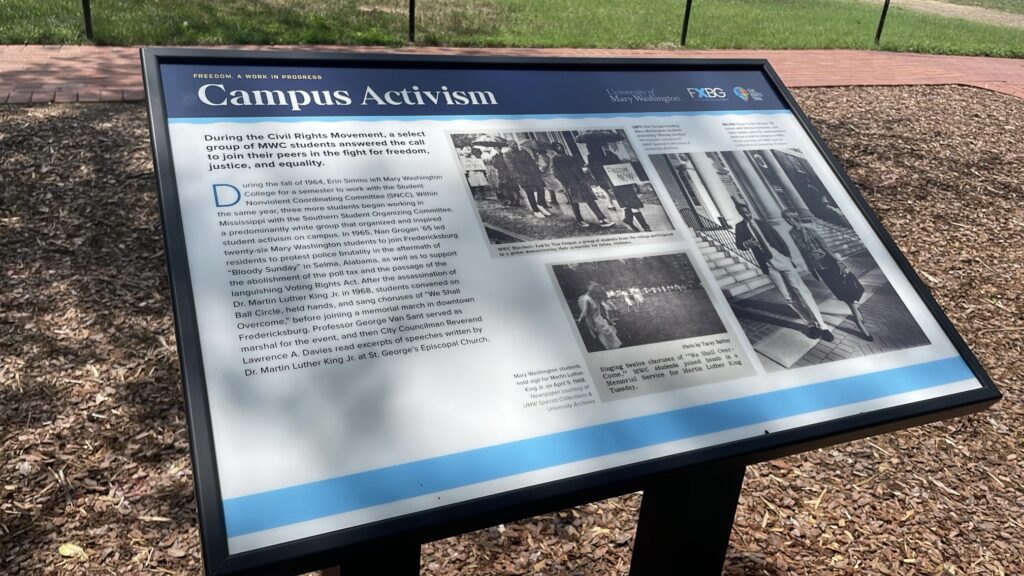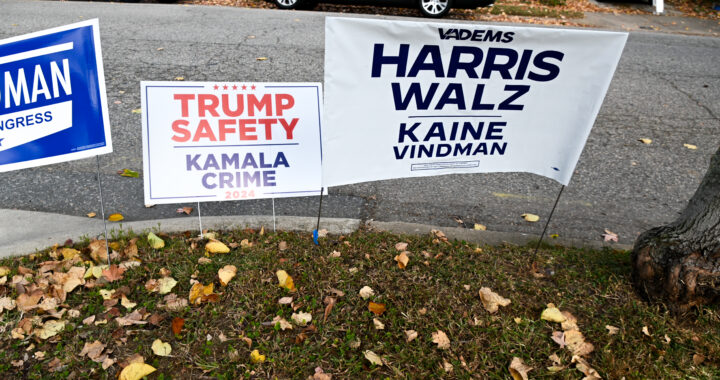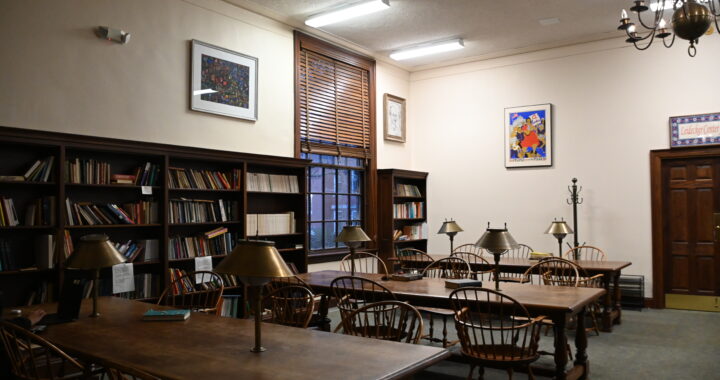Fredericksburg Civil Rights Trail honors campus activists, while UMW as an institution struggles to do the same
6 min read
The “Campus Activism” trail marker stands in front of Ball Circle, facing Lee Hall. | Claire Marshall Watkins, The Weekly Ringer
by CLAIRE MARSHALL WATKINS
Opinion Editor
Due to editor error, a previous version of this article incorrectly spelled University President Troy Paino’s last name. This version has been corrected.
In mid-July, after a quick visit to the registrar’s office in Lee Hall to submit a transfer credit re-evaluation form, I exited down the front steps facing Ball Circle where I noticed a new sign. “Campus Activism” it read, the words printed in bold lettering. And underneath: “During the Civil Rights Movement, a select group of MWC students answered the call to join their peers in the fight for freedom, justice, and equality.”
The text continued in smaller print, praising campus activists from the 1960s: Erin Simms, who left Mary Washington for a semester to work with the Student Nonviolent Coordinating Committee; Nan Grogan, who led a march against police brutality following Bloody Sunday, when Civil Rights marchers were attacked by law enforcement on the Edmund Pettus Bridge; and other unnamed students from that era who engaged in other non-violent forms of protest. The sign also informed readers of campus activists’ response to the assassination of Martin Luther King Jr—singing and holding hands on Ball Circle, then marching downtown to St. George’s Episcopal Church where students and faculty participated in a memorial service.
To say I was shocked upon seeing the sign is an understatement. I was baffled, honestly, that the university would erect a sign honoring and celebrating student activism just three short months after Virginia State Police arrested a dozen campus activists, nearly all of them students, for nonviolently protesting the slaughter of Palestinians in Gaza.
I posted a picture of the sign to my Instagram story and immediately received an influx of messages from upset friends and fellow students. People were hurt by this hypocrisy. How dare the university install this sign just after devastating my peers and violating our freedom? How dare they silence our fight for justice, then praise the very principle?
Following the arrests of those peaceful protestors on Jefferson Square on April 27, I was one of 17 students who met with University President Troy Paino to discuss this injustice. During the meeting, as he scrambled to justify the arrests, Paino continually contradicted himself. It would have been fine to have the tents if there had been no “outsiders,” he said at one point, claiming that some present community members were known to local law enforcement.
Someone pointed out to him that after the students who were arrested graduated, by his logic, they would then be the very “outsiders” of whom he disapproved. Later in the meeting, Paino said that it would have been fine to have non-UMW Fredericksburg community members present if there had been no tents.
Paino quoted Martin Luther King Jr. in an attempt to justify the arrests. He also referenced the late civil rights leader and UMW faculty member James Farmer, and declared that since those arrested from the encampment were participating in an act of civil disobedience, they were thus asking for the arrests. I really wish I was joking, but he regurgitated these sentiments in an email he sent to the entire campus a few days later.
This section of his email reads as follows:
Don’t these arrests violate the legacy of James Farmer?
I do not think so. Much like James Farmer and other civil rights activists of the 1960s, the 12 protesters engaged in an act of civil disobedience, which they are entitled to do. But civil disobedience is distinct from First Amendment-protected speech. It involves breaking a law and accepting the consequences. I do not agree that a prohibition to build an encampment in this context is unjust, but the protesters took a different view and chose to civilly disobey.
The Reverend Martin Luther King Jr. described civil disobedience in this way: “When one breaks the law that conscience tells him is unjust, he must do it openly, he must do it cheerfully, he must do it lovingly, he must do it civilly – not uncivilly – and he must do it with a willingness to accept the penalty.”
The fact of the matter is, the encampment was booked and approved through the Student Activity Board, and it wasn’t until April 26, that organizers were told that the encampment posed an alleged safety risk. There was no mass communication, and the university changed its protocol in live time, so it would have been impossible for everyone to receive this information. The university set a trap and violated its own ASPIRE values.
With this in mind, I quickly deemed the sign hypocritical and upsetting. Later that day, I looked closely at the picture I took of it so I could do some digging.
I learned that the university didn’t install this sign at all. The “Campus Activism” sign is one of five new markers along the Fredericksburg Civil Rights Trail, the product of extensive research and passion championed by Victoria Matthews, City of Fredericksburg Tourism, Stadium and Sales manager, and Chris Williams, assistant director of the James Farmer Multicultural Center. The markers on campus, Part Two of the citywide trail, recognize several aspects of the Movement where they intersected with Mary Washington:
- “The Big Five,” honoring a group of five women who attended Mary Washington in the mid-1960s who were some of the first Black students at the College;
- “Campus Desegregation,” which honors the first Black students and faculty members at the University;
- “James Farmer Multicultural Center,” which opened in 1990 and has since operated as a space for multicultural programs and events, and was renamed in 1998 after Farmer, a distinguished professor of history at the school and recipient of the Presidential Medal of Freedom;
- “Campus Activism”;
- and “Breaking Barriers,” the final marker in the series which highlights Claudith “Dottie” Holmes, one of “The Big Five,” who served as the first president of the Afro-American Association (now the Black Students Association), advocated for Black male admissions to the college, and laid the framework for the African American Studies minor.
“We have been working on this for over a year in advance, prior to anything that happened from a global standpoint,” said Williams. “Part Two [of the Fredericksburg Civil Rights Trail] has always been here on campus. This was part of the initiative in 2020 when we first got together.”
“We had students who traveled to Mississippi to help with Freedom Summer, which I think is amazing,” he added. “We had Mary Washington College students, then, take that torch and run with it. I think it should be celebrated. It’s a noteworthy achievement to have young people your age back then who saw, ‘I can really make a difference,’ and then make a difference.”
At the unveiling of these markers on July 16, Paino told attendees that he hoped they would serve as “a symbol of hope for our students.” According to an article in the FXBG Advance, Paino also said the markers are “on brand” for the university.
Some students said they weren’t on board with the president’s comments.
“I disagree with [Paino], because it takes more than just a historic reminder for change to happen and for student activism to be acknowledged,” said Vivian Pearl Wilkins, a sophomore political science and international relations double major. “I think that lessons on the signs would hold more significance if the stories were also recent events of students exercising their First Amendment right, especially since UMW was a segregated women’s college.”
I recognize and admire the effort, dedication, history and time that went into the creation and expansion of the Fredericksburg Civil Rights Trail. Williams and Matthews set the date for the unveiling as four years to the day after the project began, though they moved it up a day due to scheduling issues. They began working specifically on Part Two in the fall of 2023 with the help of Stephen Hanna, professor of geography, and Christine Henry, associate professor and director of the Center for Historic Preservation.
As with nearly everything, the timing of these two events—the arrests and the unveiling—prompt nuanced discourse. I believe that the addition of these markers to the Trail is important, with significant historical and educational value, while at the same time, the timing of the installation calls for us to challenge the university on the authenticity of its values, especially pertaining to its alleged support of campus activism. I wish the university was consistent in living up to its moral claims.
As one student recently asked: “Are we a university that believes in ethics or are we a business?”


